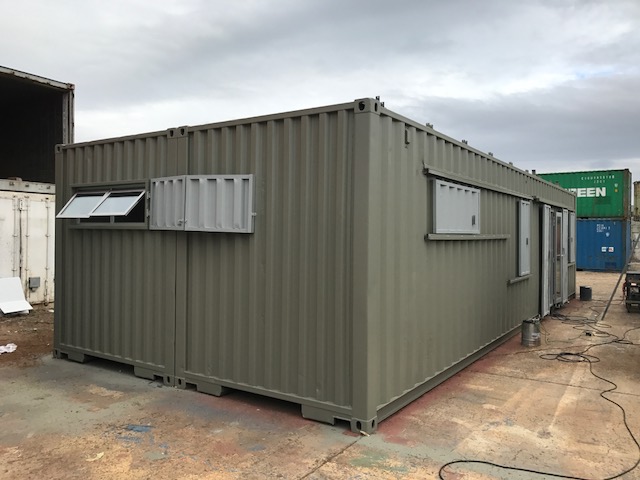Taking on the project of building a home from recycled shipping containers represented, in many respects, a steep learning curve. At first glance there were two broad areas of know-how required: reliable information, especially about products and materials and, solid project management skills.
Reliable information
If you really want to be on top of things, you need to have at least a fair understanding of available materials, products and building methods. It is imperative that you don’t simply trust the opinions of your local hardware shop! My own experience has shown that, often, certain products, materials and building methods are used instead of others because they are familiar – not because they are substantially superior to alternative (e.g. greener) options.
Take enough time to do the necessary research yourself so that you are informed when you talk to service providers such as builders, electricians, architects etc. Our research phase took close to a year but, in the end, we knew exactly what we wanted. One thing that I am very certain about: if you don’t know enough, someone else will make critical decisions for you that YOU will have to live with in your home, not they.
And here’s another tip: don’t just read about it on websites and in brochures. Take the time to go and look at it. Nothing beats holding the material in your hand; tangibly comparing it to something else. You can spend an immensely valuable couple of hours in a large Build It, Builder’s Warehouse or Agrimark. Part of the process of gathering information is creating your understanding of what products are about, what they can offer you. This should ideally include a basic understanding of measurements, quantities, and technical specs.
Think of it as a tasting menu in a restaurant: you have to sample before you can decide if you like it or not.
The following are worthwhile sources of information to explore:
- Pinterest can provide you with great photos to help conceptualise what you would like something to look like. It is often also a lead to more robust technical information.
- Similarly Facebook pages or groups, such as Earthship South Africa and Talking Natural Homes, can be a valuable source of information.
- Eco Exibit that is part of the permanent Building Centre Exhibition
- Eco Home
- The Green Building Council of South Africa
- The SANS 10400 Building Regulations
- Sustainability.co.za – an online shop offering a big variety of sustainable solutions.
- The How-to of Building. Practical Building Guide – a great practical guide for building projects.
Good project management
I’m blessed to be a “natural” project manager, so this part of the process didn’t require anything that I have not done before. The project management process of an alternative building project is no different to project managing a social development programme or a policy development process. What I am very sure about is that if you are embarking on a building project you definitely need a project manager. If you are unable do it yourself, find someone who can do it for you. Managing a building project takes a lot of time, no matter how organised you are. Ideally it is not something you want to try and fit in between other things – unless you enjoy being stressed out!
Here are qualities that you want in a project manager:
- Organised
- Trustworthy
- Reliable
- On time
- Specific
- Pro-active
- Decisive
- Good communication
Keep the following basic project management steps in mind:
Have a good idea of what you want: Define the project.
- Think, discuss and imagine the options.
- What are the best product and material options?
- How will it work?
- How do the different aspects all link up?
- Will it be easy enough to operate and maintain?
- Is it what you want?
- Weigh-up short-term costs vs longer-term maintenance costs.
Draw up a project management plan with a realistic timeframe and budget. Clarify and outline at least the following scheduling steps:
- Identify the logical activities of the project
- Plan starting and completion dates – even if these change later
- Estimate the duration of each activity
- Identify and give specific attention to critical activities
- Modify the schedule regularly
You can look at the following Project Management Schedule Example. Various straight forward apps, such as Microsoft Project Timeline or Wunderlist can make project management a lot easier.
Get the necessary trades’ people on board, e.g. builder, conversion team, engineer, electrician, plumber etc.
Run the project:
- Have regular meetings with service providers.
- Bring service providers together e.g. the engineer, roof specialist and builder/conversion team.
- Follow-up regularly.
- Use e-mail as an easy paper trail and checklist.
- Keep all project documentation together in one place (whether electronic or hard copy).
- Have a dedicated project book (or electronic folder) to make notes in when you’re visiting retailers, suppliers, service providers etc.
Our lessons learned about information and project management:
YOU have to make it happen – even the project manager will take her/his lead from you.
- If you’re not on top of it – it will be on top of you!
- There’s no substitute for holding the actual product or material in your hand.
- The more YOU understand products, materials and methods the less room for error there is.
- Effective project management and good knowledge and understanding will alleviate a lot of the stress associated with a building project.

The final coat of paint on the walls and shutters
For more information e-mail info@findmegreen.co.za.

